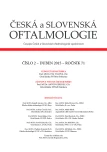Clinical Results after Continuous Corneal ring (MyoRing) Implantation in Keratoconus Patients
Authors:
P. Studený; D. Křížová; Z. Straňák; P. Kuchynka
Authors‘ workplace:
Oční klinika FNKV a 3. LF UK, Praha, přednosta prof. MUDr. Pavel Kuchynka, CSc.
Published in:
Čes. a slov. Oftal., 71, 2015, No. 2, p. 87-91
Category:
Original Article
Overview
Purpose:
to present one and two years clinical results after intrastromal continuous corneal ring implantation in keratoconus patients.
Methods:
Retrospective evaluation of the results of patients with keratoconus, after MyoRing implantation for improving of visual functions. The uncorrected distance visual acuity (UDVA), best corrected distance visual acuity (CDVA), the residual subjective refractive error, pachymetry, keratometry and the size of corneal astigmatismus were evaluated. Peroperative and postoperative complications were investigated. The minimal follow-up time was 12 months.
Results:
The study included 32 eyes of 30 patients with mean age of 30.08 (± 11.56) years.
UDVA improved from 1.03 (± 0.41) logMAR to 0.36 (± 0.25) logMAR 12 months and 0.31 (± 0.27) logMAR 24 months after surgery. These changes were stastistically significant. The maxima value of corneal curvature (Kmax) was preoperatively 52.48 (± 6.35) D, 46.08 (± 4.44) D 12 months and 45.53 (± 5.52) D 24 months after surgery. Both changes were statistically significant (P ˂ 0,00000). The mean value of corneal curvature (K mean) was preoperatively 50.10 (± 4.96) D, 44.25 (± 4.40) D 12 months and 44.11 (± 5.38) D 24 months after surgery. Both changes were statistically significant. In any of the patients we did not register any severe peroperative or postoperative complication.
Conclusion:
The MyoRing implantation is an effective and safe method in improvement of visual functions in keratoconus patients. Clinical results are stable in one and two years follow-up time.
Key words:
continuous corneal ring, MyoRing, keratoconus
Sources
1. Alio J.L., Piñero D.P., Daxer A.: Clinical outcomes after complete ring implantation in corneal ectasia using the femtosecond technology: a pilot study. Ophthalmology, 2011; 118: 1282–90.
2. Alió J.L., Shabayek M.H.: Corneal higher order aberrations: a method to grade keratoconus. J Refract Surg, 2006; 22(6): 539–45.
3. Colin J., Cochener B., Savary G. et al.: INTACS inserts for treating keratoconus: one-year results. Ophthalmology, 2001 Aug; 108: 1409–14.
4. Daxer A., Mahmoud H., Venkateswaran RS.: Intracorneal continuous ring implantation for keratoconus: One-year follow-up. J Cataract Refract Surg, 2010; 36(8): 1296–302.
5. Daxer A., Mahmoud HA., Venkateswaran RS.: Corneal crosslinking and visual rehabilitation in keratoconus in one session without epithelial debridement: new technique. Cornea.
6. Daxer A.: Adjustable intracorneal ring in a lamellar pocket for keratoconus. J Refract Surg, 2010; 26: 217–221.
7. Galvis, V., Tello, A., Gomez, AJ. et al.: Corneal Transplantation at an Ophthalmological Referral Center in Colombia: Indications and Techniques (2004–2011). Open Ophthalmol J, 2013; 17; 7: 30–33.
8. Haddad W., Fadlallah A., Dirani A. et al.: Comparison of 2 types of intrastromal corneal ring segments for keratoconus. J Cataract Refract Surg, 2012; 38: 1214–21.
9. Jabbarvand M., Salamatrad A., Hashemian H. et al.: Continuous intracorneal ring implantation for keratoconus using a femtosecond laser. J Cataract Refract Surg, 2013; 39: 1081–7.
10. Mahmood H., Venkateswaran R.S., Daxer A.: Implantation of a complete corneal ring in an intrastromal pocket for keratoconus. J Refract Surg, 2011; 27(1): 63–8.
11. Módis, L., Jr., Szalai, E., Facskó, A. et al.: Corneal transplantation in Hungary (1946-2009). Clin Exp Ophthalmol, 2011; 39: 520–5.
12. Němcová I., Pašta J., Madunický J.: Léčba keratokonu implantací intrastromálních rohovkových prstenců in Trendy soudobé oftalmologie svazek 5, Praha: Galén,2008, 281 s.
13. Piñero D.P., Alio J.L.: Intracorneal ring segments in ectatic corneal disease – a review. Clin Experiment. Ophthalmol, 2010; 38: 154–67.
14. Raiskup-Wolf F.: Crosslinking pomocou riboflavínu a UVA-žiarenia pri ektatických degeneraciach rohovky in Trendy soudobé oftalmologie svazek 5. Praha: Galén, 2008, 281 s.
15. Raiskup-Wolf F., Hoyer A., Spoerl E. et al.: Collagen crosslinking with riboflavin and ultraviolet-A light in keratoconus: long-term results. J Cataract Refract Surg, 2008; 34: 796–801.
16. Sheldon, C.A., McCarthy, J.M., White, V.A.: Correlation of clinical and pathologic diagnoses of corneal disease in penetrating keratoplasties in Vancouver a 10-year review. Can J Ophthalmol, 2012; 47: 5–10.
17. Spoerl E., Huhle M., Seiler T.: Induction of cross-links in corneal tissue. Exp Eye Res. 1998; 66: 97–103.
18. Tunc Z., Helvacioglu F., Sencan S.: Evaluation of intrastromal corneal ring segments for treatment of keratoconus with a mechanical implantation technique. Indian J Ophthalmol, 2013; 61: 218–25.
Labels
OphthalmologyArticle was published in
Czech and Slovak Ophthalmology

2015 Issue 2
Most read in this issue
- STORY of the Papilla - a Case Report
- Clinical Results after Continuous Corneal ring (MyoRing) Implantation in Keratoconus Patients
- Acute Zonal Occult Outer Retinopathy – a Case with Rapid Return of Visual Functions in Type 3 Disease
- Aflibercept in Clinical Practice
